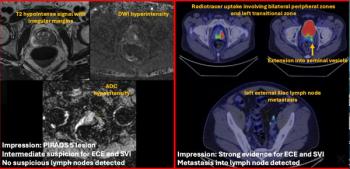
CT angiography excels for head and neck vascular trauma
The use of multislice CT angiography has increased detection of vascular injury in patients suffering head and neck trauma, prompting debate on whether whole-body screening or focused attention on the head and neck is more useful. Both methods had their proponents at an RSNA session on emergency radiology.
The use of multislice CT angiography has increased detection of vascular injury in patients suffering head and neck trauma, prompting debate on whether whole-body screening or focused attention on the head and neck is more useful. Both methods had their proponents at an RSNA session on emergency radiology.
Rates of blunt cervical vascular injury detection have increased from between 0.1% and 0.8% to between 1% and 5%, depending on the selection criteria used for scanning, said keynote presenter Dr. Stuart E. Mirvis, a professor of diagnostic radiology at the University of Maryland.
Up to 20% of patients with blunt cervical vascular injury have no classic risk factors, and about 30% of patients experience injuries to multiple vessels. Early use of anticoagulants can reduce the risk of stroke and other adverse outcomes in these patients.
Some injuries are more closely associated with vascular injury than others. A retrospective review by Dr. Nila H. Alsheik and colleagues at the University of Wisconsin-Madison of 1975 patients presenting to a Level 1 trauma center showed that patients with injuries that affect the carotid canal are most likely to experience cerebrovascular injury (CVI). Nearly half of the patients presenting with midface or mandibular fractures also showed evidence of vascular injury.
"Identifying patients at high risk of CVI can help physicians determine whether focused CTA scans are warranted while the patient is still on the table," Alsheik said.
Another retrospective study of 276 patients by Dr. John Kim and colleagues of Boston University School of Medicine concluded that cervical spine or skull base fractures are more likely to indicate vascular injuries than other craniofacial injuries.
Rather than rely on focused head and neck CTA, Dr. Alessandro Lemos and colleagues from the Ospedale Maggiore in Milan concluded that whole-body CTA should be the method of choice for blunt cervical vascular injury in multisystem trauma patients. Researchers found comparable sensitivity, specificity, and accuracy between the two approaches regarding cervical artery injuries.
Whole-body CT is time-efficient, results in lower radiation dosage than focused CT, and allows simultaneous evaluation of vascular and parenchymal structures, Lemos said.
Newsletter
Stay at the forefront of radiology with the Diagnostic Imaging newsletter, delivering the latest news, clinical insights, and imaging advancements for today’s radiologists.




























